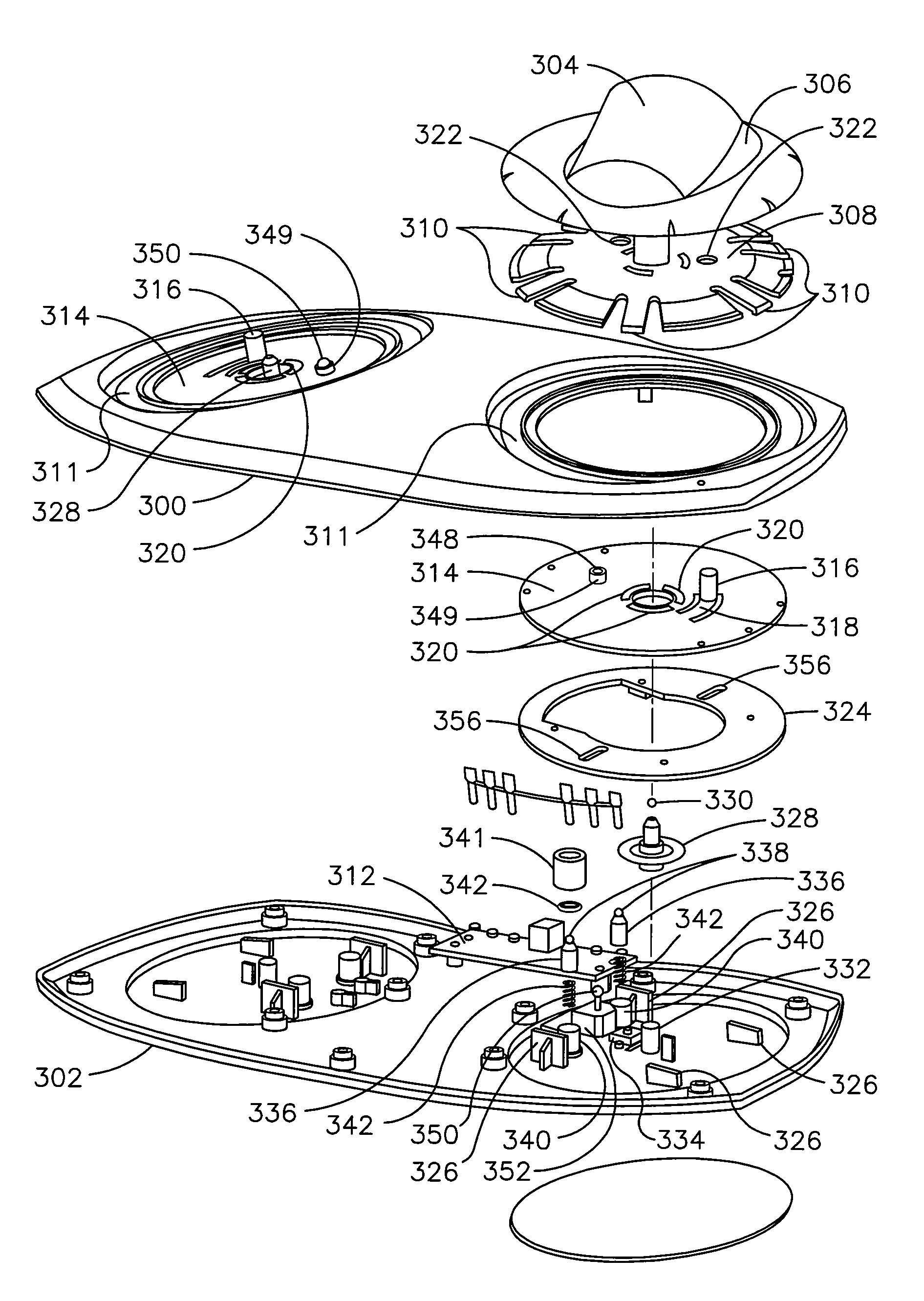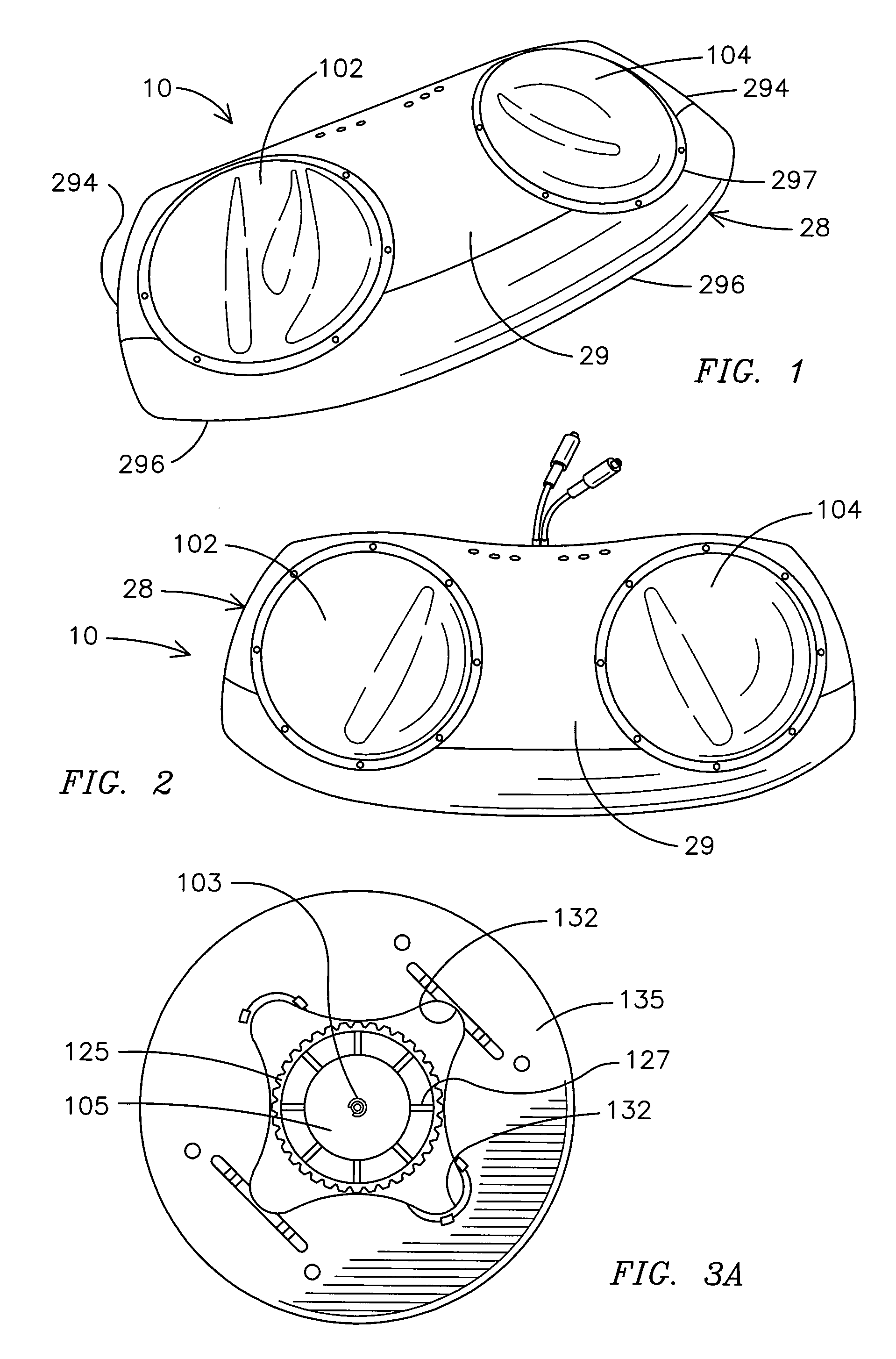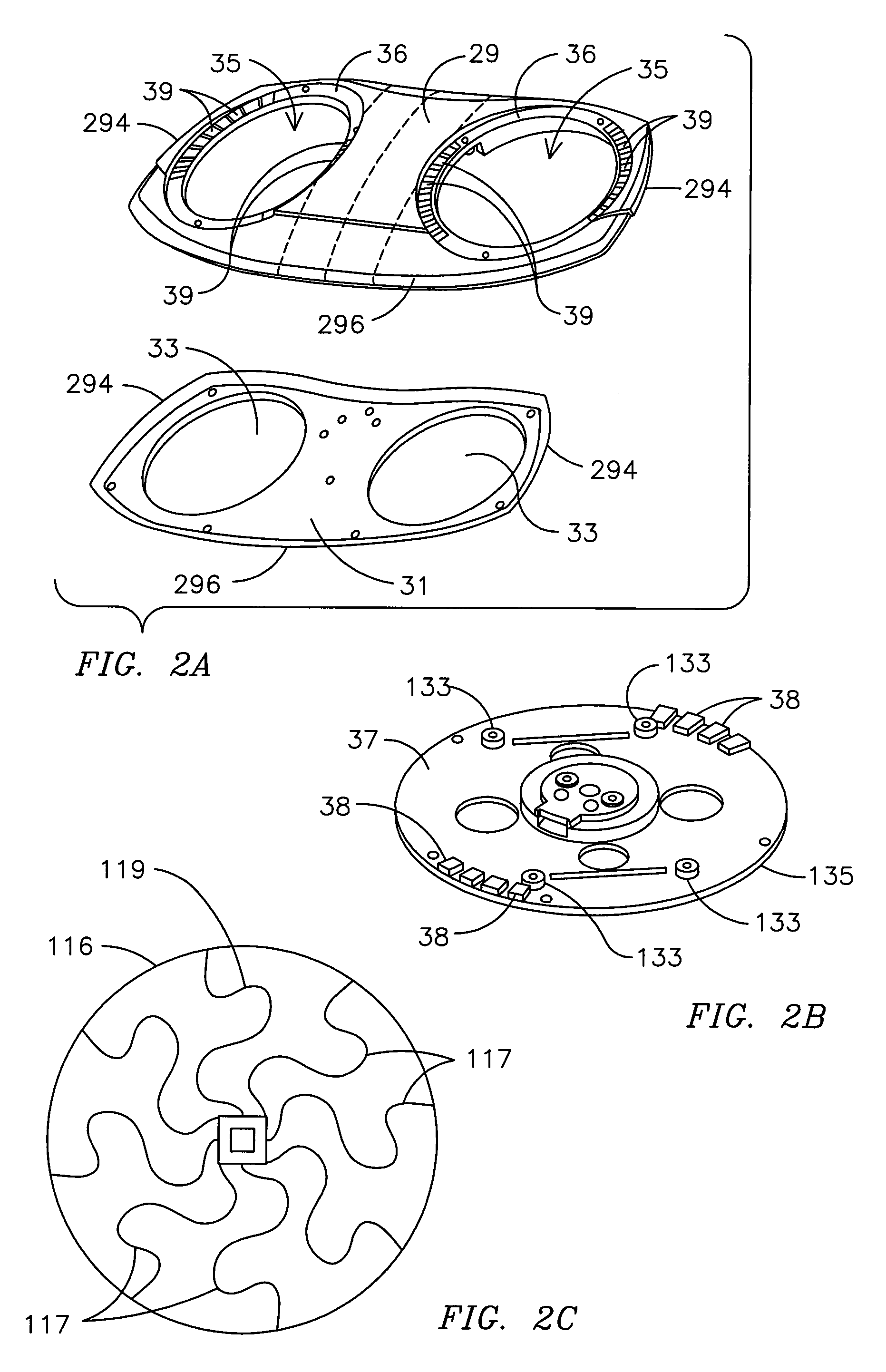[0014]One exemplary embodiment allows for accessing a set of keystrokes by generating signals indicative of the location or movement of each
input device or dome used alone or jointly. A color-coded annulus may be provided for each dome in accordance with aspects of the present invention wherein each annulus may contain indicia that provide a correspondence between dome attitude and keystroke. Each annulus may be affixed to the top edge of the apparatus base wall where each is visible. Another exemplary embodiment allows for generating a
data signal indicative of a keystroke by combining movement of one or more domes with switching the apparatus among various operating
modes such as a “num lock” mode, a “shift” mode, a “shift-lock” and / or a “caps lock” mode, for example. Using the movement or position of one or both domes in combination with various
modes increases the number of keystrokes available for generating alphanumeric or other special characters or functions.
[0015]Various embodiments of the invention described herein require no appreciable hand or wrist motion and no finger motion. Instead, the movement required is relatively small such that only a slight motion of a user's arms is required to output a desired keystroke. More specifically, use of various embodiments requires little shifting of the hand from a
rest position and does not require wrist rotation for maneuvers that are performed on conventional keyboards by the four fingers and the
thumb. Since the fingers are not required to perform any maneuvering for
typing, instead of focusing on finger-tip activation, various embodiments of the present apparatus require only slight motion of a person's arm and / or hand for actuation of keystrokes. Also, the left hand and right hand domes, in one exemplary embodiment, may have different switches to activate various keyboard functions. For example, in the left hand dome a switch may be provided at the location of the top surface of the upper director plate. Applying vertical pressure to the dome may activate this switch. When the switch has not been depressed, a first set of unique keystroke signals may be available, as described above. A single depression and release of the dome allows for access to a second set of keystroke signals that may be equal in number to the first set. For example, depressing and holding of the left dome may access the “shift” function or depressing and releasing the left dome may activate the “shift-lock” function.
[0016]In another aspect of the present invention, switching means may be provided for selectively altering or controlling the location of a cursor by placing one dome into a “mouse” mode. A single sequential depression and release of the right hand dome, for example, may allow that dome to act as a positioning cursor or “mouse”. This vertical actuation may disengage the spider mechanism from the dome to allow the dome freedom of movement for cursor control. In this respect, the spider mechanism may move vertically between one of two positions on vertical actuation by the right hand dome. An engaged position allows the spider member to seat firmly in the flower pedal impressions to aid in dome guidance. A disengaged position may place the spider mechanism in a position so it is not seated in the flower pedals impressions. The disengaged position allows for the kinematic map plate the about freely in 360 degrees for cursor control. To effect this capability, one exemplary embodiment allows for an opposing ramp geometry or camming mechanism to be seated within a center aperture of the spider mechanism. In one exemplary embodiment, as the spider mechanism is depressed via the dome, a plurality of camming protruberances within the aperture may engage the ramps or camming surfaces causing the spider mechanism to disengage from the kinematic map plate and rotate approximately 45 degrees. Depression of the dome may also actuate a switch that enables the mouse mode. The spider mechanism may re-engage the underside of the kinematic map plate after rotation and release of the dome at points that do not contain the flower-pedal impressions. Concave impressions may be formed on the underside of the kinematic map plate for receiving posts of the spider mechanism allowing for the dome's freedom of movement. When the dome is depressed and released again the spider mechanism may rotate and re-engage the flower-pedal impressions and the keyboard mode may be enabled.
[0017]In another exemplary embodiment, depression of the dome may lower the spider mechanism without rotation to a position below the kinematic map plate and retain it in that position. In this respect, the camming mechanism may rotate within the aperture formed in the kinematic map plate to activate the mouse mode and retain the spider mechanism below the kinematic map plate via the camming protuberances and surfaces so the dome is in the “
free form” position. When the camming mechanism is rotated and the mouse switch is activated the mouse mode is initiated. Once initiated, the electronic logic of a control
processing module may sense the mode and allow for mouse cursor movement using the right hand dome. In one exemplary embodiment the left hand dome may then be used for the mouse left, right, and middle clicks and one embodiment allows for up to sixteen different clicks to be programmed in the apparatus. This type of built-in cursor or “mouse” activation and control allows a user to keep their hands on the respective domes continuously for total hand on-board
typing and cursor control. In one exemplary embodiment the right switch may be mounted on the top surface of the upper director plate on the right hand dome
assembly. Applying vertical pressure to the dome may activate this switch. When the switch has not been depressed, a first set of unique keystroke signals may be available. A single depression and release of the dome allows for access to the mouse navigation
signal.
[0018]Another exemplary aspect of the present invention allows for palm and finger rests or pads to be provided on one or both of the domes that engage and support the hand during motion of the hand when moving a respective dome rather than being contoured to only fit the shape of a static hand. Various aspects of the present invention allow for maximum flexibility in defining character location, activation force, activation displacement, and physical orientation of the apparatus. For example, it can be used by a physically challenged individual because it will permit
adaptation to his or her unique physical requirements. In addition, because
finger movement may be totally eliminated, individuals with partial hand or finger
paralysis or absence can still manipulate the apparatus. Additional flexibility is provided in that variable dome sizes may be made to accommodate any user. In recognition that a “one-size-fits-all” approach may not be entirely appropriate to deal with users' hands that are significantly larger or smaller than a “median”
hand size, various embodiments of the present invention allow for different dome sizes to accommodate a range of hand sizes and finger spans. In addition, it can be appreciated by one skilled in the art that other ergonomically satisfactory shapes besides contoured domes may be utilized, such as balls or flat boards, for example.
[0019]
Miniaturization of conventional keyboards has been a difficult task because of the need to accommodate human fingers. One exemplary embodiment of the invention described herein allows for easy
miniaturization and requires the use of only one finger, such as the
thumb, of each hand, to operate the apparatus. For example, an exemplary embodiment of a
thumb controlled mechanism disclosed herein can be implemented as a pair of thumb-operated elements on the face of computing devices such as a Palm
Pilot® or Game Boy® hand-held units, for example. Further, since various embodiments of the present invention contain no unitary “keys” requiring independent movement, it is possible to make the apparatus completely sealed for weatherproofing so that they are hostile-environment ready. Their design allows for total
enclosure and therefore protection from water,
dirt, dust, etc.
 Login to View More
Login to View More  Login to View More
Login to View More 


